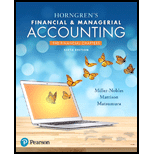
1.
Time value of money: Any amount invested today earns an additional income, called interest income, after a certain period. This is called as time value of money.
Present Value: The value of today’s amount expected to be paid or received in the future at a compound interest rate is called as present value.
Effective-interest amortization method: Effective-interest amortization method it is an amortization model that apportions the amount of bond discount or premium based on the market interest rate.
In this method, first, interest expense is calculated based on the current carrying amount and market interest rate and cash interest payment is calculated based on the face value amount and stated interest rate and then, the different between the cash interest payment and interest expense is amortized as a decrease to the discount or premium.
Amortization Schedule: An amortization schedule is a table that shows the details of each loan payment allocated between the principal amount and the overdue interest along with the beginning and ending balance of the loan. From the amortization schedule of the loan, the periodical interest expense, total interest expense and total payment made are known.
To calculate: The amount (present value) that company receive upon the issuance of the bonds payable.
2.
To prepare: An amortization table using the effective interest amortization method for the first two semiannual interest periods.
3.
To Journalize: Issuance of the bonds on January 1, 2018.
To Journalize: First semiannual interest payment and amortization of the bonds.
To Journalize: Second semiannual interest payment and amortization of the bonds.
Trending nowThis is a popular solution!

Chapter 12 Solutions
Horngren's Financial & Managerial Accounting, The Financial Chapters Plus MyLab Accounting with Pearson eText -- Access Card Package (6th Edition)
- I need help with accounting questionarrow_forwardchoose best answerarrow_forwardA company has three divisions, X, Y, and Z, with the following financial data: • Sales for Division X: $1,800,000 Investment in assets for Division X: $630,000 What is the asset turnover (AT) for Division X? A. 1.43 B. 1.60 C. 1.67 D. 2.86 E. 3.33arrow_forward
- Standard cost per unit is calculated as: A. standard rate per hour multiplied by standard time. B. standard price multiplied by standard quantity. C. Standard quantity divided by standard price. D. service units used divided by available service units.arrow_forwardGeneral accountingarrow_forwardWhat was the gain or loss on the sale of the equipmentarrow_forward
- ??arrow_forwardCorrect Answerarrow_forwardA manufacturer incurred the following costs to produce one unit of a product: • Direct Material: Rs. 120 • Direct Labour: Rs. 180 • Selling Expenses: Rs. 40 Selling Price per Unit: Rs. 700 Overhead Expenses per Unit: Rs. 120 (50% variable overheads) Calculate the Contribution per Unit of the Product.arrow_forward

 AccountingAccountingISBN:9781337272094Author:WARREN, Carl S., Reeve, James M., Duchac, Jonathan E.Publisher:Cengage Learning,
AccountingAccountingISBN:9781337272094Author:WARREN, Carl S., Reeve, James M., Duchac, Jonathan E.Publisher:Cengage Learning, Accounting Information SystemsAccountingISBN:9781337619202Author:Hall, James A.Publisher:Cengage Learning,
Accounting Information SystemsAccountingISBN:9781337619202Author:Hall, James A.Publisher:Cengage Learning, Horngren's Cost Accounting: A Managerial Emphasis...AccountingISBN:9780134475585Author:Srikant M. Datar, Madhav V. RajanPublisher:PEARSON
Horngren's Cost Accounting: A Managerial Emphasis...AccountingISBN:9780134475585Author:Srikant M. Datar, Madhav V. RajanPublisher:PEARSON Intermediate AccountingAccountingISBN:9781259722660Author:J. David Spiceland, Mark W. Nelson, Wayne M ThomasPublisher:McGraw-Hill Education
Intermediate AccountingAccountingISBN:9781259722660Author:J. David Spiceland, Mark W. Nelson, Wayne M ThomasPublisher:McGraw-Hill Education Financial and Managerial AccountingAccountingISBN:9781259726705Author:John J Wild, Ken W. Shaw, Barbara Chiappetta Fundamental Accounting PrinciplesPublisher:McGraw-Hill Education
Financial and Managerial AccountingAccountingISBN:9781259726705Author:John J Wild, Ken W. Shaw, Barbara Chiappetta Fundamental Accounting PrinciplesPublisher:McGraw-Hill Education





